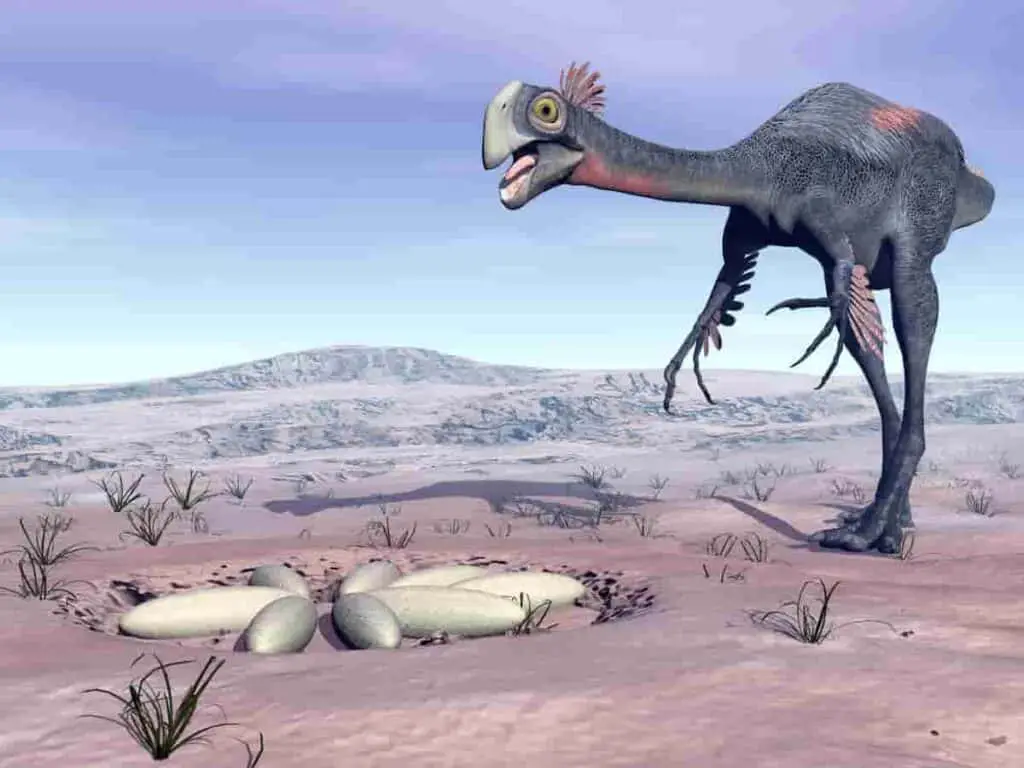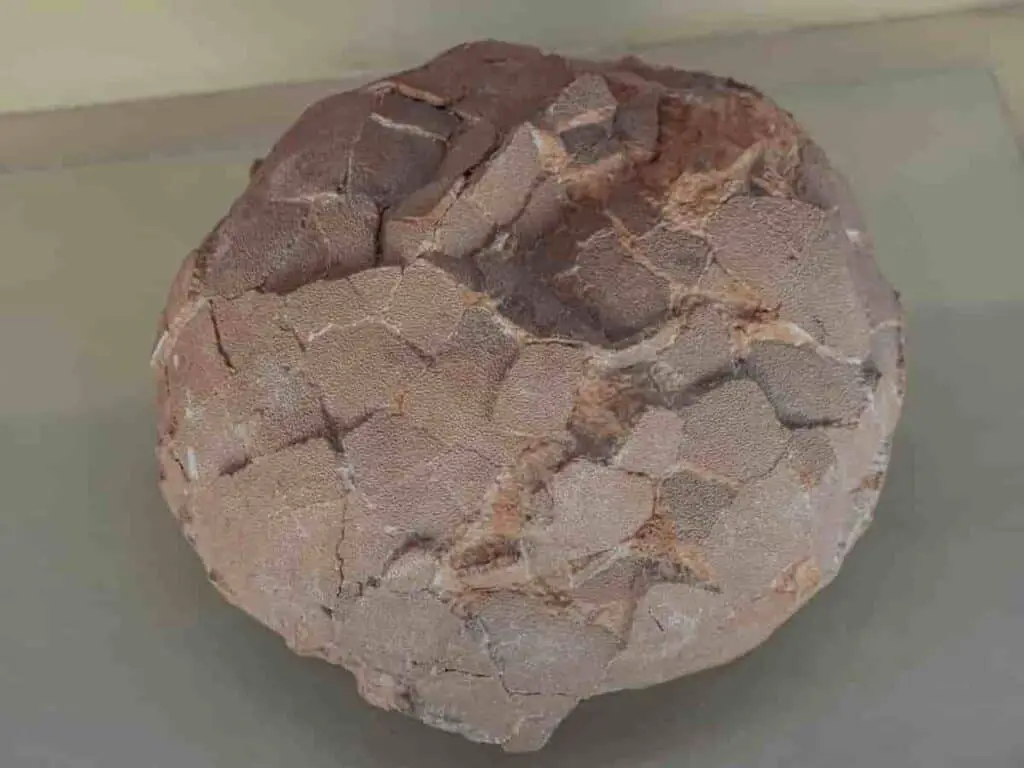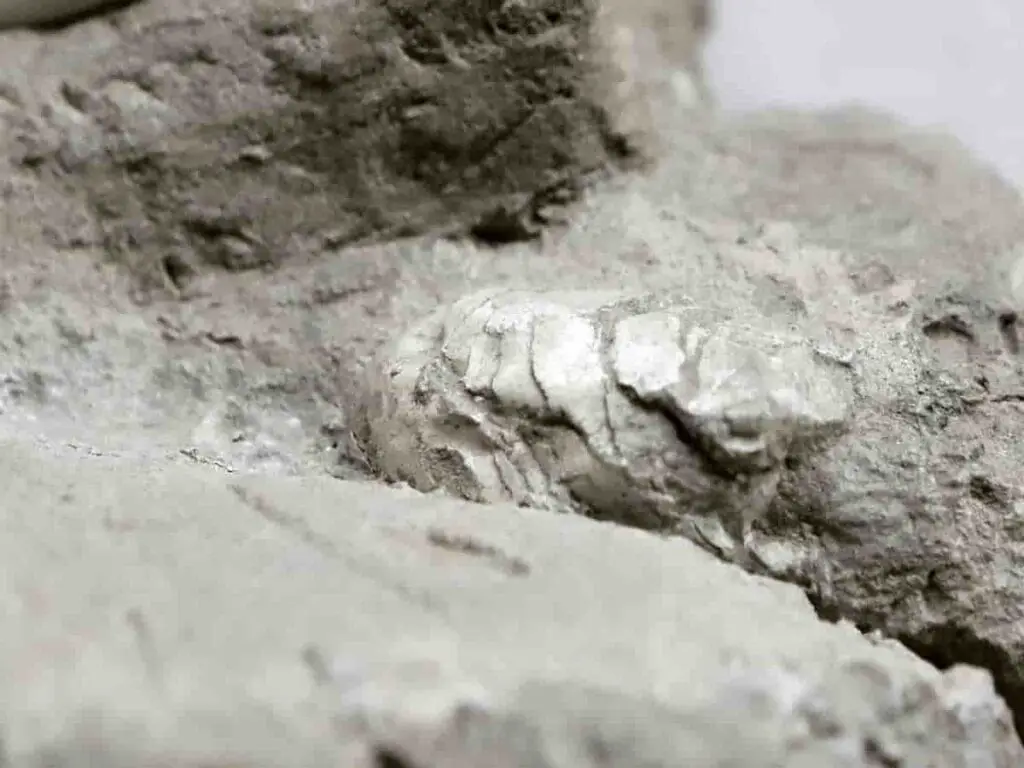How Big Are Dinosaur Eggs? If you’ve read many articles on this website, you’ll know that dinosaurs come in various shapes and sizes and that non-avian dinosaurs (like sauropods and hadrosaurs) laid eggs. That may make you curious about the size of eggs that dinosaurs could lay. For instance, how big were dinosaur eggs on average?

How Big Are Dinosaur Eggs?
In general, the range from 8 to 12 inches long and two to five inches wide, but that varies by species and whether elongated eggs or round in shape. The Macroelongatoolithus currently holds the record for the biggest dinosaur eggs, about 18 inches long and six inches wide. (Source)
Dinosaurs, the magnificent creatures of the prehistoric era, reproduced primarily by laying eggs, a fact revealed through meticulous paleontological studies. Intriguingly, the sizes of dinosaur eggs were not uniform, but rather diverse, mirroring the varied species of dinosaurs.
For instance, the colossal Tyrannosaurus Rex laid substantial eggs, reflecting its size, in sharp contrast to the eggs of smaller species like the agile Velociraptor. Some species, such as the Oviraptor, wrongly implicated in the fossil record as an egg thief, are known to have laid characteristic eggs.
Table of Contents
The bird-like dinosaur Troodon, famed for its intellect, exhibited an intriguing nesting behavior; it buried eggs in a manner akin to present-day birds. Data extrapolated from the fossil record also sheds light on diversity in egg shells of different species. The theropods, a group encompassing the Tyrannosaurus Rex and Velociraptor, laid robust, hard-shelled eggs. In contrast, some Ornithischians, another significant dinosaur group, produced soft-shelled eggs.
Documentation on the eggs of Sauropodomorphs, the group boasting some of the largest dinosaurs ever to exist, is still under exploration. Across the paleological community, the lack of a uniform correlation between dinosaur size and egg size continues to spark interest.
Consequently, these ancient creatures ceaselessly enthrall, establishing an intriguing insight into a lost world, documented eloquently in stone and held within the fossil record.
Today’s guide will discuss the dinosaur species responsible for the smallest and largest eggs in history. We’ll also look at raptors, tyrannosaurids, sauropods, and duck-billed hadrosaurs to examine the respective sizes of their eggs.
Let’s begin!
Which Dinosaur Lays the Biggest Eggs?
If you read our post about dinosaur eggs with embryos still inside, you’ll recall that we talked about Baby Louie, one of its most prominent (if not the most) embryos. You might be wondering how big were dinosaur eggs, if it was one of the larger species of dinosaur.
Baby Louie was uncovered in central China’s Hunan Province among a collection of eggs that were six inches wide by 18 inches long.
Those eggs, it turns out, were Macroelongatoolithus eggs, an oogenus of theropod eggs. The Macroelongatoolithus itself is not a dinosaur species but the classification for these larger-than-life dinosaur eggs.
Besides China, Macroelongatoolithus eggs have been uncovered in Nevada, Wyoming, Montana, Idaho, Utah, and South Korea.
Which dinosaur species lay eggs this large, you ask? It seems logical that the largest species would lay the largest eggs. Experts, however, still aren’t sure. But there are two schools of thought. Let’s examine.
Oviraptosaurs
Originally, paleontologists believed that tyrannosaurs must have laid the eggs, but that wasn’t feasible.
One of the likeliest dinosaur species associated with the very large Macroelongatoolithus eggs is oviraptorosaurs such as the Gigantoraptor.
The Gigantoraptor was a huge beast, measuring 29 feet long and weighing over two tons.
Baby Louie himself further proves that Macroelongatoolithus eggs were likely laid by oviraptorosaurs.
Paleontologists reviewed the embryo’s perinatal remains to determine that his jawbone was like oviraptorids’ jaws.
Suppose it does indeed turn out that oviraptorosaurs hatched the Macroelongatoolithus eggs. In that case, this will prove that during the Cretaceous Period, in what is today North America, oviraptorosaurs would have been prevalent. Thie includes larger species like the Gigantoraptor.
Caenagnathidae

If not oviraptorosaurs, the chances are high that theropod dinosaurs could have laid the biggest dinosaur eggs in the Caenagnathidae family. These dinosaurs belonged to the maniraptoran clade and were akin to modern birds.
They, too, lived during the Cretaceous Period in Asia and North America, so both the timeline and the location add up.
So why would some paleontologists suspect that Caenagnathidae dinosaurs laid such large eggs?
Paleontologists did further research on Baby Louie in 2017 after the embryo was uncovered in the early 1990s. The research revealed that oviraptorids might not have hatched the Macroelongatoolithus eggs.
The jury is still out, though!
More Large Dinosaur Eggs
Although the Macroelongatoolithus might be the largest dinosaur egg we know of right now, that doesn’t mean other large eggs aren’t out there.
For example, a Titanosaur egg from the Late Cretaceous Period about 70 million years ago was discovered in France. The egg was largely intact, as it was spherical and showed off the intricate texture of the cracked egg.
The egg fossil was owned by a private collector and sold, although it’s unclear who the lucky buyer was.
Spanish paleontologists also found at least 30 Titanosaur eggs back in 2021, reports the Hindustan News Hub.
Up to 70 eggs uncovered at the Loarre excavation site may have been uncovered. Many were under layers of stone.

What Is the Smallest Dinosaur Egg?
From the huge eggs of the Macroelongatoolithus, it’s now time to switch gears and talk about which dinosaur eggs are the smallest.
It is a relatively recent find reported by Guinness World Records in 2020. According to Guinness, the tiny egg fossil measured 45 millimeters by 20 millimeters.
That makes it the smallest non-avian fossilized dinosaur that Guinness World Records knows of.
Here’s some more information about this perpetually small dinosaur egg. The fossil was unearthed in Japan, specifically in Tamba City, Hyogo. As a dinosaur lover, you might be aware of this part of Japan, as many fossils have been found here.
The reason? It took millions of years, but soils around since the Lower Cretaceous Period about 110 million years ago have finally become accessible. Dinosaur remains are sometimes exposed, making finding them a lot easier.
The eggs that were recovered around 2020 are believed to come from theropods. Each egg weighs 10 grams on average, give or take, equivalent to quail eggs.
So who is this dinosaur with the very small eggs? That would be the Himeeolithus murakami.
We don’t know a lot yet about this dinosaur. Illustrations guessing the creature would have looked like make the Himeeolithus murakami look like a small bird with feathers contrasting light gray and darker black around the face and tail.
Its eggs are depicted to have the same coloration as some modern birds, as the eggs look teal to dark green with large spots throughout.
The finding of the small, fossilized eggs is truly something special. We can’t wait to learn more about the small dinosaur that would have come from these eggs and why the eggs were so very tiny.
Comparisons Between Different Species and Their Dinosaur Egg Sizes
To wrap up, we want to delve further into several dinosaur species and the sizes of the eggs each species laid. This section will show you that egg size was usually commensurate with the size of the dinosaur laying the eggs.
In the case of chickens, lizards, fish, and insects, it continues to be the case today that eggs are proportional to the animal’s size.
Duck-Billed Hadrosaurs
Let’s start with duck-billed hadrosaurs in the Hadrosauridae family. This dinosaur lived during the Late Cretaceous Period throughout what is today North America and Asia (sound familiar to you? It should!).
The average size of a duck-billed hadrosaur was between 10 and 65 feet long. The name hadrosaur does translate in part from Greek to mean “thick” or “stout.”
Hadrosaur eggs were between 3.5 and seven inches in diameter. The eggs almost looked like rocks with their unique coloration, which could have been a method of disguise to avoid predators from hunting and feasting on the eggs.
Eggshells belonging to hadrosaurs have been uncovered in Montana’s Judith River and Two Medicine Formations and southern Alberta, Canada’s Devil’s Coulee, and Dinosaur Park Formation.
Unfortunately, hadrosaur eggs are often confused for other dinosaur fossils and faked, distinguishing the real ones.
Sauropods
The sauropod clade included mostly long-necked dinosaur species, although the neck size of sauropods got progressively smaller. During the Jurassic and Cretaceous eras, there were also prosauropods and titanosaurs, which produced the largest species of dinosaur. The Cretaceous sauropods have been found in North and South America, Europe, and Asia.
Let’s look at one of the larger sauropods, the diplodocus, and see what kinds of eggs this dinosaur laid.
The diplodocus genus lived during the Late Jurassic Period in what is North America’s midwest today.
This dinosaur boasted a very long neck and a tail that was even longer. The diplodocus was about 85 feet long in total.
Smithsonian Magazine states that diplodocus eggs were about the size of big grapefruit, so these eggs were by no means small!
Tyrannosaurids
We have to talk about everyone’s favorite dinosaur family, the Tyrannosauridae, where the famed and feared T. Rex fits in.
The dinosaurs in this family lived during the Late Cretaceous Period, with fossils uncovered in modern-day Asia and North America.
If you’ve read our other posts, you’ll have realized that T. Rex was not that big of a dinosaur. He was about 43 feet tall but was heavy, weighing between 9.3 and 15.4 short tons.
The eggs of the T. Rex were huge by comparison. A 2020 article from National Geographic reports that the average size of a T. Rex egg was 17 inches long. That’s nearly half the body length of a fully mature T. Rex!
Conclusion
Dinosaur eggs range in size from about the equivalent of golf balls to bigger than grapefruits. The larger the dinosaur species, typically, the bigger the eggs.
We can still learn more about dinosaur eggs on both sides of the size spectrum, but the information we already have is incredibly fascinating!
